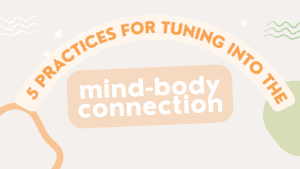Have you ever experienced emotions combined with physical symptoms? You may be experiencing what is known as mind-body connection! In this article, we are going to explore what exactly mind-body connection is, ways to get in tune with our mind-body connection, and strategies to improve the connection!
What is the Mind Body Connection?
Mind-body connection occurs when our emotions and physical symptoms are in synch with each other. Therefore, when we experience various emotions, both good and distressing, we experience physical symptoms with them. From “butterflies in the stomach” when feeling love to crying when upset, you experience examples of mind-body connection on a regular basis.
Where the mind-body connection starts to get complicated is how when we respond to threat. You may be familiar with the expression “fight or flight” which has been recently expanded to freeze and fawn (to respond to threat through pleasing). Our emotions and physical responses to our emotions and threats are also regulated through the mind-body connection.
Two aspects of our biology that is responsible for the mind-body connection are our vagus nerve and cortisol. The vagus nerve is a part of our parasympathetic nervous system that is responsible for the fight-or-flight response. Cortisol is the stress hormone of the body. Together, they can impact you both emotionally and physically.
Why is This Important?
Understanding mind-body connection is an important part of mental health and wellbeing. First, understanding mind-body connection helps with realizing that the physical symptoms of emotions that you experience are, in fact, very real. You do not need to be concerned if the stomach in knots or difficulty breathing is “all in your head,” because it is not!
Second, is the good news that we can get in touch with or mind-body connection and there are multiple ways to improve our dynamics with our mind-body connection. If uncomfortable physical symptoms are part of the bad side of mind-body connection, being in tune with yourself and managing your symptoms to feel well is the positive side. We are now going to discuss ways to get in touch with, and improve, your mind-body connection.
Getting in Tune With Your Mind-Body Connection
How do you begin to be aware of the connection between your mind and your body? Each time you begin to experience emotion, ask yourself, what do I feel in my body? Conduct a body scan- start at the top of your head and imagine you are examining yourself head down to your feet as you notice any sensations or feelings in your body. How is your heart rate? Do you feel warm? How does your stomach feel? Take your time, and over time, you may notice connections between physical symptoms with different emotions.
Allow yourself to experience whatever you notice, and simply pay mind to it without giving it too much weight. For instance, if you notice your heart is faster than you would like or your jaw is sore, don’t worry. Remember, being mindful of what is going on in your body isn’t a scary thing, it just means these are areas to be mindful of as you work to improve your mind-body connection.
Exercises to Improve Mind-Body Connection
Engage With Your Senses
Play around with your five senses to not only get in touch with the present moment, but to also experience physical elements of emotion management. For this exercise, you can use any of your senses, so play around with them and see what works best for you.
- Sight: what are the things you can name that you see in the room around you or out the window? Can you name the colors, or count patterns?
- Sound: What sounds do you hear? Can you put on comforting sounds?
- Smell: Utilize candles, perfume, or essential oils and which scents bring you comfort and promote positive mind-body connection.
- Touch: Try feeling different items of textures, and ask yourself how do you feel touching the different textures?
- Taste: Take your favorite snack or non-alcoholic drink and eat or drink it slowly. What ingredients and flavors do you pick up on? How does it feel to slow down and savor the food/drink?
Which sense(s) help achieve positive mind-body connection for you? What makes you feel more centered and well in your body?
Find Movement That is Right for You
Movement is a great way to put yourself in a positive mood and manage your symptoms along the way. It is also important to know, though, what type of movement works well for you. For example, the sensations that come with high intensity interval training (HIIT) may be a positive adrenaline rush for some, but may lead to anxiety in others. Know what types of movement work well for you. Do you enjoy yoga, or a specific sport, or biking? There is no correct answer to the best movement, but it is important to know what works well for you.
The goal of this strategy is that by the time you are done you should feel good about the exercise that you did, and a sense of wellbeing that you did. You may feel sore after movement, and that is normal, but you shouldn’t feel bad about yourself for the movement you chose.
Breath-work
Breathwork is another great way to help promote positive mind-body connection. During breathwork, not only are you regulating your breath, but you will also get to naturally regulate your heart rate and evaluate your thoughts along the way.
Breathwork comes in many forms from guided breathwork to meditation. Find what works best for you.
Next Steps
Mind-body connection takes time to achieve, but with practice and finding strategies that work well for you, it can become much easier! Just know that you do not have to learn how to do so on your own. Our team of experts are happy to assist!





Leave A Comment